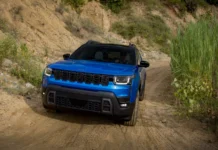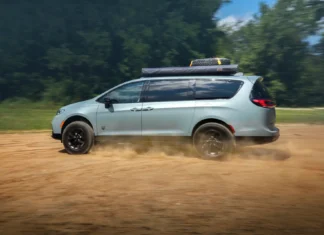Guys, I need your help.
I’ll jump right out the gate with this review from a slightly different angle than usual — one that fully acknowledges my status as TFL’s resident Mazda fanboy. We recently had the opportunity to test a 2021 Mazda CX-30 Turbo, plus we’ve tested the naturally-aspirated versions in the recent past. In fact, check out that review against the new Kia Seltos if you’re also in the market for a small crossover. The turbocharged crossover addressed my biggest complaint with the standard car: its engine. So, now that they’ve made a faster version, should I trade in from my 2016 Mazda CX-5? I’m not so sure…
Apart from just taking a closer look at the 2021 Mazda CX-30 Turbo, I wanted your opinion on whether I should upgrade. Is it worth trading into this car, or maybe it’s best to get into something else? For those who are looking to bone up on the CX-30 themselves, Tommy also put together a deeper dive here.
Getting to know the 2021 Mazda CX-30 Turbo
So, what is there to know about the turbocharged CX-30? The model is already Mazda’s second-best-selling crossover (after it’s larger CX-5 brother). Now, just like the CX-5, you have the option for a substantial increase in oomph, but in a smaller, Mazda3 hatch-based package. As it is a crossover, as evidenced by the huge amount of black plastic cladding, you’re getting a more adventurous package than the sportier Mazda3. In normal driving conditions, the development goal was to make the Turbo model handle the same as its naturally-aspirated version, just with the extra power. Apart from suspension tweaks to cope with the turbocharged engine’s extra weight, it feels similar to a regular CX-30.
Under the hood, the 2.5-liter mill is the same unit that’s now ubiquitous across the entire Mazda lineup. On premium fuel, it manages 250 horsepower and 320 lb-ft of torque. Dial it back to regular (87 octane), and those figures drop a bit to 227 horsepower and 310 lb-ft of torque. Honestly, you don’t really feel a huge difference between the two, as the power makes its way to all four wheels through a six-speed automatic transmission. The engine feels nice and torquey down low, and that sort of profile also helps its case for off-road driving. At the end of the day, the CX-30 Turbo isn’t a sports car nor a hardcore performance crossover, but it’s still satisfyingly quick zipping around city streets and longer highway stretches.
I need to register one criticism, and it’s this: If you do actually try to redline the car during an acceleration run, it will hesitate, if only for a moment, before shifting up. I can’t help but to think the 6-speed auto, snappy as it is, could benefit from a couple extra gears, but as it stands the system works well enough as a complete package.

Remarkably upscale interior for the price
Don’t get me wrong, the 2021 Mazda CX-30 Turbo is a hoot to drive, hence why I’m thinking about trading into it. Even better than that, though, is how far Mazda’s come with their interiors in just the past few years. The brand is aiming upmarket in its latest generation, and you see that in all the materials. Especially in Turbo trims, the combination of power and interior refinement matches the significantly more expensive BMW X2 and Mercedes-Benz GLA 250.
Pricing starts at $31,720 (including destination) for the base Turbo trim. That is a healthy price hike on the standard CX-30, but you do get more standard equipment for the money, as well as the extra power. There are more trim options still in either the Premium or Premium Plus models. At the top of the range, the $35,225 fully-loaded version crams in every feature Mazda can manage at the moment. That’s where the luxury crossovers start, so depending on how you slice it the CX-30 Turbo still comes in as a good value.
An 8.8-inch touchscreen infotainment system still comes standard, as is the case across the range. You get Apple CarPlay and Android Auto support, as well as radar cruise control as standard equipment. The Turbo Premium model adds a Bose 12-speaker audio system, power liftgate and leather seats. At the top end, the Premium Plus adds in an excellent (especially compared to older Mazdas) 360-degree camera system and Traffic Jam Assist.
Plenty of endearing features, but are there any drawbacks?
The 2021 Mazda CX-30 Turbo maintains the brand’s reputation as the driver-focused option. You won’t see the sort of hooliganism you may remember from old Mazdaspeed models, but this car pulls off the clever trick of bringing good power and refinement to the table.
But is it worth the extra cash to trade over my five-year-old CX-5? That’s honestly a tough question for me to answer. Over the years, I’ve garnered some major complaints to be sure. The paint is hysterically flimsy, as is the windshield. I’m about to get into my third since I bought the car. Mazda’s last generation models suffer on road and wind noise — the new CX-30 is a massive improvement.
On the other hand, I still really love the first-generation CX-5, even after five years. Its 8.5 inches of ground clearance (to the CX-30’s 6.9 inches) makes me pause, as I’d like a car that has the all-around capability to head into some remote (but not too terribly difficult) terrain. With 184 horsepower on tap, the naturally-aspirated engine isn’t the most potent, but the old CX-5 isn’t a heavyweight either. Not only did it beat out a second-generation CX-5 in a drag race, but it’s only a bit heavier than a CX-30 Turbo. And with the extra power comes a fuel economy penalty: The CX-30 Turbo manages 22 City / 30 Highway / 25 City mpg. That said, at least I’m not losing fuel economy over my current car.
There are financial implications of course, but I won’t get into those details here. I enjoy the CX-30, but I’m curious what suggestions you may have for me (or anyone else) looking to trade. Get a CX-30, or maybe get into something else? Let me know whether you’d consider this car or one of its rivals instead in the comments.





























